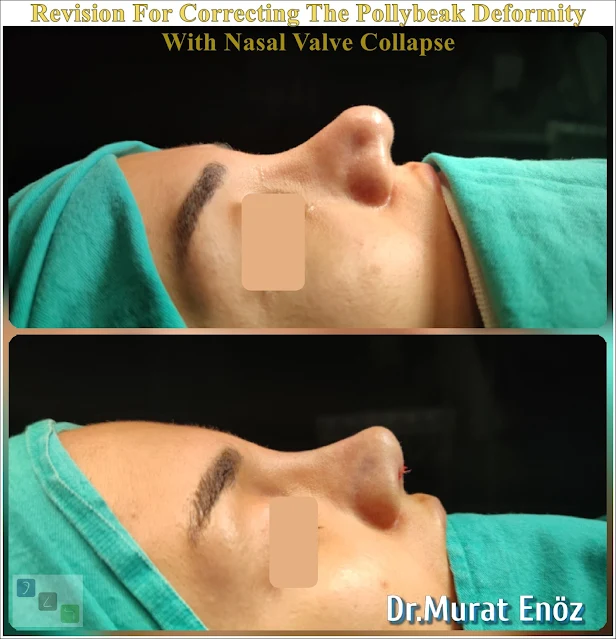Parrot Beak Nose Deformity and Alar Collapse
In the images and videos below, you can see the patient's nose before and after the operation.
Why does Pollybeak deformity occur?
Pollybeak Deformity may occur due to the presence of more than normal cartilage tissue in the supratip region (insufficient supratip excision) - cartilaginous beak nasal deformity, the presence of skin and thick subcutaneous tissue in the supratip region (soft tissue pollybeak deformity) or insufficient projection at the tip of the nose. It may occur due to surgical procedure, trauma, genetic structure or abnormal tissue edema.
How is Pollybeak deformity treated?
Cartilaginous pollybeak deformity can be corrected by excision of the excess cartilage tissue in the supratip region and/or increasing the nasal tip projection.
Soft tissue pollybeak deformity can be treated by excision of the subcutaneous tissue in the supratip region with bilevel dissection, augmentation of the dorsum, and increasing the nasal tip projection.
In patients with thick skin, who have an appearance of pollybeak deformity in the early period after nasal operations, night pressure taping of the nose, application of cortisone to the nose after the 4th month may reduce soft tissue edema and reduce the possibility of pollybeak deformity.
Considerations to avoid pollybeak deformity during rhinoplasty in patients with thick skin
In patients with thick skin, leaving the supratip level slightly lower than the nasal tip level (clearance of the supratip break point) may be the first precaution to avoid pollybeak deformity. The reason for this is that in patients with thick skin structure, unexpected skin sub-tissue edema occurs after the operation and causes the supratip region to rise more anteriorly. In patients with thick skin, if after the operation, pressured sleeping time taping, salt restriction in the diet, nasal massage with cold arnica gel, drinking green tea, using bromelain and increasing edema in the supratip region and a parrot-like appearance appear despite all these recommendations, 4. Cortisone injection into the nose can be planned, which can be started from 6 months and can be done at 3-4 months intervals. You can take a look at the Steroid Injection After Rhinoplasty link that I have prepared in detail on this subject.
The link I prepared in detail about nasal taping at bedtime after rhinoplasty operation >> Taping After Rhinoplasty Is Effective For Swelling in Thick-Skinned Patients!
Again, in patients with thick skin features, it is important not to leave a third dead space under the skin. Especially when dead space is left in the spratip and nasal tip area, it may facilitate the production of abnormal subcutaneous healing tissue and subcutaneous edema, rounded appearance at the tip of the nose and the emergence of pollybeak deformity. After thick-skinned rhinoplasty, I especially recommend my patients not to smoke, as tissue healing may be adversely affected and edema may last for an abnormally long time.
Nose fillers can be used in some patients for the treatment of pollybeak deformity
In patients with polly beak nasal deformity, which are not particularly severe and do not require surgery, nasal fillings containing hyaluronic acid can be chosen as "non surgical treatment of polly beak deformity" in the treatment. However, it is not suitable for every patient.
How to determine the cost of Pollybeak deformity treatment in Istanbul?
The surgical procedure applied in pollybeak nasal deformity is like the classical revision rhinoplasty operation; therefore, the price is determined as drevision rhinoplasty. In patients who require additional cartilage grafts and materials, the price increases in luxury and upper segment hospitals. Generally, the cost of pollybeak nasal deformity operation in Istanbul is between 3500-5500 us dollars. Only the filler injection fee is around 300-350 US dollars. The cost of cortisone injection into the nose, which can be applied to patients who develop pollybeak deformity in the early period after rhinoplasty, is around 150-200 US dollars.
Murat Enoz, MD, Otorhinolaryngology, Head and Neck Surgeon
Private Office:
Address: İncirli Cad. No:41, Kat:4 (Dilek Patisserie Building), Postal code: 34147, Bakırköy - İstanbul
Appointment Phone: +90 212 561 00 52
Appointment Phone: +90 212 561 00 52
Fax: +90 212 542 74 47

















Comments
Post a Comment